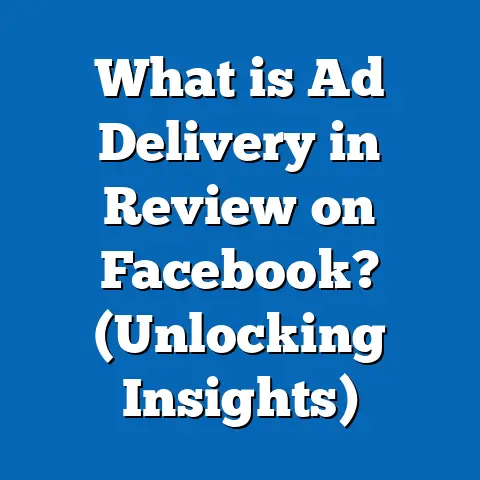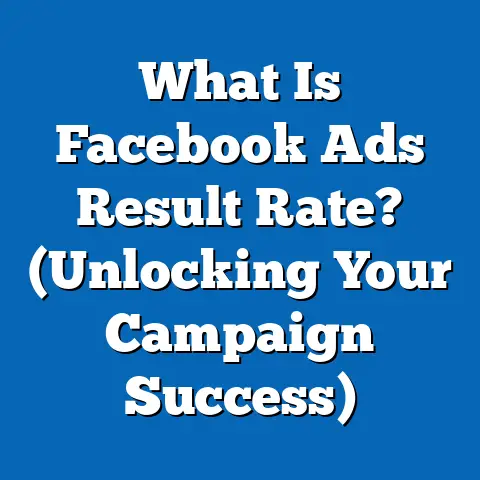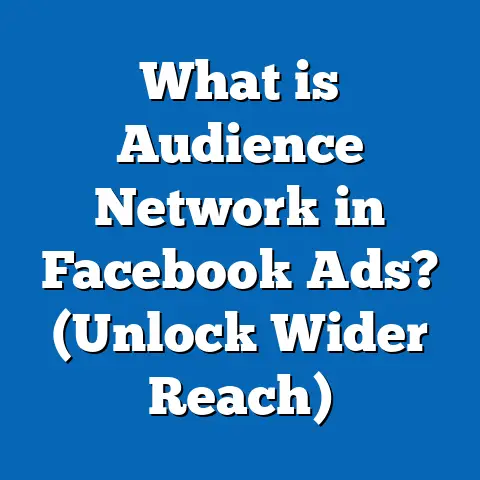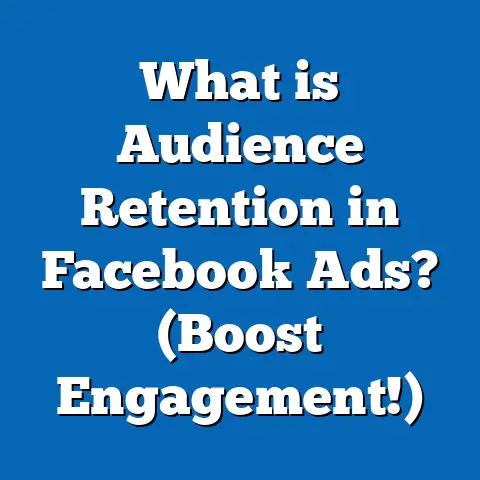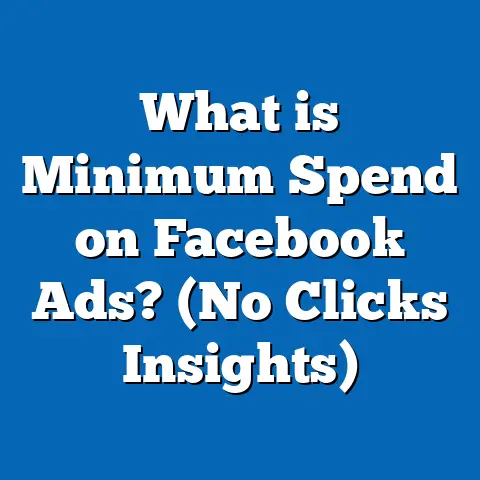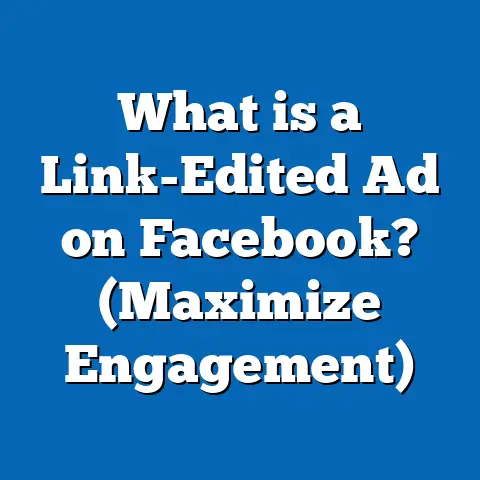What is a Good Result Rate for Facebook Ads? (Unlock Profits)
What is a Good Result Rate for Facebook Ads? (Unlock Profits)
Imagine you’re fishing in a vast lake filled with countless fish. You’ve got the best bait, but how many fish do you catch? That catch rate is your “result rate” in Facebook ads — it measures how effectively your ad campaign reels in customers and profits. Just like fishing, understanding what a good result rate is can be the difference between a fruitful haul and an empty net. Over the years, I’ve navigated countless Facebook ad campaigns for small and medium businesses across the USA, and I’ve learned that knowing your benchmarks and tools is critical to turning ad spend into revenue.
Current Facebook Ads Market Trends and Statistics
Let’s start by understanding why Facebook advertising still matters in 2024. Despite new platforms popping up every year, Facebook remains one of the most powerful marketing channels for businesses targeting American consumers.
Facebook at a Glance
- 2.9 billion active users worldwide, with about 240 million in the U.S. alone.
- Around 70% of U.S. adults use Facebook daily, making it a prime place to engage potential customers.
- Over 10 million active advertisers compete for attention on Facebook.
- The average daily time spent on Facebook by users is about 30 minutes, indicating high engagement levels.
- About 45% of SMBs in the U.S. invest in Facebook ads, highlighting its importance for local businesses.
Advertising Spend and ROI
- Average Cost Per Click (CPC) in the U.S. ranges from $0.50 to $3.00 depending on industry competitiveness.
- Typical Click-Through Rate (CTR) varies widely but averages around 0.9% to 1.6% for most industries.
- Conversion rates fluctuate between 2% and 10%, affected by product type and sales funnel quality.
- Businesses report an average Return on Ad Spend (ROAS) of 4:1, meaning every $1 spent returns $4 in revenue.
Industry Variance Is Key
Different industries see vastly different results:
| Industry | Average CTR | Conversion Rate | Average CPC (USD) | Average ROAS |
|---|---|---|---|---|
| Retail / eCommerce | 1.6% | 5% – 8% | $0.70 – $1.20 | 4:1 |
| B2B Services | 0.5% – 1% | 4% – 7% | $1.50 – $3.00 | 3:1 |
| Health & Fitness | 1.2% | 6% – 10% | $0.80 – $1.50 | 5:1 |
| Finance | 0.8% | 3% – 6% | $1.00 – $3.00 | 3:1 |
| Travel & Hospitality | 1.0% | 2% – 5% | $0.90 – $2.00 | 3:1 |
This diversity underscores why knowing your niche’s benchmarks is crucial before judging your campaign’s performance.
What Does “Result Rate” Mean in Facebook Ads?
Understanding result rate means getting clear on what metric you’re measuring, because Facebook ads can have multiple goals:
- Awareness: Impressions, reach, brand recall.
- Engagement: Likes, comments, shares, video views.
- Traffic: Clicks to website or landing pages.
- Leads: Form submissions or sign-ups.
- Conversions: Sales or other key actions.
- Retention: Repeat purchases or app engagement.
Typically when marketers ask “What is a good result rate?” they focus on:
Click-Through Rate (CTR)
This metric shows the percentage of people who clicked your ad after seeing it: CTR=ClicksImpressions×100%\text{CTR} = \frac{\text{Clicks}}{\text{Impressions}} \times 100\%
CTR measures how compelling your ad creative and targeting are combined.
Conversion Rate
Of those who clicked, how many took your desired action? Conversion Rate=ConversionsClicks×100%\text{Conversion Rate} = \frac{\text{Conversions}}{\text{Clicks}} \times 100\%
This reflects how well your landing page and offer convert visitors.
Return on Ad Spend (ROAS)
The ultimate profitability metric showing revenue earned per dollar spent: ROAS=Revenue from AdsAd Spend\text{ROAS} = \frac{\text{Revenue from Ads}}{\text{Ad Spend}}
A ROAS > 1 means profit; most businesses aim for at least 4:1 for sustainable growth.
Cost Per Acquisition (CPA)
How much you pay to gain one customer or lead: CPA=Total Ad SpendNumber of Conversions\text{CPA} = \frac{\text{Total Ad Spend}}{\text{Number of Conversions}}
Lower CPA improves profit margins.
What is a Good Result Rate? Benchmarks by Metric and Industry
From my experience managing dozens of campaigns across industries, here’s a breakdown of what I consider good benchmarks, based on data and real-world outcomes.
Click-Through Rate (CTR)
| Industry | Good CTR Benchmark |
|---|---|
| E-commerce | 2% – 3% |
| B2B Services | 0.5% – 1.5% |
| Health & Fitness | 1.5% – 3% |
| Finance | 0.8% – 1.5% |
| Travel | 1% – 2% |
Conversion Rate
Varies widely depending on product complexity:
- Simple product offers (e.g., retail): 5%-10%
- Higher-consideration sales (e.g., B2B software): 2%-5%
- Lead generation forms: 7%-12%
Return on Ad Spend (ROAS)
A healthy ROAS depends on your business model but a general rule:
- Minimum acceptable: 3:1
- Ideal for growth: 4:1 or higher
- Some e-commerce brands target 7:1 or more during peak seasons
Cost Per Acquisition (CPA)
This depends heavily on customer lifetime value (CLV). For example:
- If CLV = $200, try to keep CPA under $50.
- If CLV = $500, CPA can be up to $125 or more.
Personal Experience: Real Stories That Bring These Numbers to Life
Case Study #1: A Texas Furniture Store’s Transformation
When I first met this mid-sized furniture retailer, their Facebook ads were bleeding money — CTR hovered at a dismal 0.4%, and conversions were below 2%. They were spending thousands monthly with little return.
What changed?
- We revamped their audience targeting using Facebook Audience Insights to focus on homeowners aged 30-55 within a 50-mile radius.
- Created fresh creatives emphasizing their unique craftsmanship with lifestyle images.
- Added retargeting ads for website visitors who didn’t purchase initially.
Results:
Within three months:
- CTR rose to 1.7%
- Conversion rates jumped to nearly 7%
- ROAS increased from 2:1 to a solid 5:1
- Monthly revenue from Facebook ads doubled
Their story highlights how knowing benchmarks helped us reset expectations, optimize campaigns, and unlock profits.
Case Study #2: Florida Gym’s Lead Capture Success
A local gym targeting young professionals was stuck at a CTR of around 3%, but conversions lagged at just 3%. They relied on users clicking through to their website for sign-ups — too many dropped off.
Solution:
- Implemented ManyChat chatbots on Facebook Messenger to capture leads instantly.
- Offered free trial sign-ups directly within Facebook without needing website navigation.
Outcome:
- Lead conversion rate soared to nearly 9%
- Cost per lead dropped by 40%
- Membership sign-ups increased significantly
This shows the power of integrating automation tools into your funnel for better results.
Breaking Down Essential Facebook Marketing Tools by Function
To consistently hit good result rates and improve over time, leveraging the right tools is essential. Here’s my organized review of key software solutions grouped by primary use case.
Ad Creation & Design Tools
Creating engaging visuals and copy that catch attention is step one.
Canva
Key Features:
- Drag-and-drop interface with thousands of templates optimized for Facebook ads
- Access to free photos, icons, fonts
- Team collaboration features for SMBs
Best Use Cases: Small businesses without dedicated designers; quick ad creation.
Pricing: Free plan available; Pro plan starts at $12.99/month with premium assets and brand kits.
Pros:
- User-friendly even for beginners
- Fast turnaround on ad creatives
- Mobile app available
Cons:
- Limited complex animation options
- Some premium assets require extra purchase
Visual Example:
VistaCreate (formerly Crello)
Key Features:
- Similar drag-and-drop editor with over 50,000 templates
- Strong focus on animated video ads
- Integration with stock video libraries
Best Use Cases: Brands wanting dynamic video ads without heavy production costs.
Pricing: Free basic plan; Pro starts at $10/month.
Pros:
- Excellent for video-based social ads
- Intuitive interface
- Large template variety
Cons:
- Limited offline editing capabilities
- Some users report performance lag on large files
Audience Targeting & Research Tools
Getting your ad in front of the right people is critical — these tools help you zero in precisely.
Facebook Audience Insights (Built-in)
Key Features:
- Detailed demographics by age, gender, location
- Interests and behaviors segmentation
- Page likes and activity data
Best Use Cases: Campaign planning; identifying customer segments in the USA.
Pricing: Free with Ads Manager account.
Pros:
- Deep data directly from Facebook’s own system
- No extra cost
- Real-time updates
Cons:
- Interface can be confusing for beginners
- Limited cross-platform data integration
AdEspresso by Hootsuite
Key Features:
- Easy A/B split testing across multiple audience segments
- Automated optimization recommendations
- Campaign performance insights with clear dashboards
Best Use Cases: SMB marketers running multiple campaigns; those wanting automated audience refinement.
Pricing: Starts at $49/month.
Pros:
- Simplifies complex testing processes
- Saves time on manual optimization
- Integrates with HubSpot and Salesforce
Cons:
- Pricing can be steep for very small businesses
- Learning curve for advanced features
Automation & Retargeting Tools
Re-engaging potential customers who showed interest but didn’t convert often provides the best ROI.
ManyChat
Key Features:
- Build automated chatbots for Facebook Messenger
- Capture leads via interactive conversations
- Segment users based on responses for personalized follow-ups
Best Use Cases: Businesses wanting instant engagement; lead generation campaigns.
Pricing: Free basic plan; Pro starts at $10/month depending on subscriber count.
Pros:
- Easy drag-and-drop chatbot builder
- Integrates with email marketing and CRMs
- Reduces friction in lead capture
Cons:
- Requires some setup time for complex flows
- Not ideal for all industries (depends on target audience tech adoption)
Retargeter
Key Features:
- Dynamic retargeting ads showing products users viewed
- Cross-device retargeting capabilities
- Advanced segmentation based on user behavior
Best Use Cases: E-commerce SMBs aiming to recover abandoned carts and increase repeat sales.
Pricing: Custom pricing based on ad budget and features required.
Pros:
- Proven to increase conversion rates significantly
- Personalized ad content boosts engagement
- Supports multi-channel retargeting (Facebook + Display networks)
Cons:
- Higher cost compared to standard retargeting options
- Requires technical integration expertise
Analytics & Reporting Tools
To make informed decisions, clear insights are non-negotiable.
Facebook Ads Manager (Built-in)
Key Features:
- Detailed breakdown of all campaign metrics
- Customizable reports by demographics, placement, device
- Real-time data tracking
Best Use Cases: All advertisers needing direct access to campaign performance data.
Pricing: Free with ad spending.
Pros:
- Comprehensive metrics covering every stage of funnel
- No extra cost
- Easy integration with other Facebook tools like Pixel and SDK
Cons:
- Complex interface can overwhelm new users
- Limited cross-platform data aggregation
AdStage
Key Features:
- Consolidates data from multiple ad platforms (Facebook, Google Ads, LinkedIn)
- Customizable dashboards and automated reporting emails
- Data visualization tools highlighting trends and ROI metrics
Best Use Cases: Agencies and SMBs running multi-channel campaigns needing holistic views.
Pricing: Starts at $99/month.
Pros:
- Saves time consolidating data manually
- Helps identify cross-channel optimization opportunities
- Supports team collaboration features
Cons:
- Pricing may be prohibitive for very small businesses
- Requires some onboarding time
How to Interpret Your Result Rates Based on Your Business Context
Knowing the numbers is one thing — interpreting them correctly in your context is another challenge altogether.
For Small Local Businesses with Limited Budgets
If you’re a local bakery or boutique spending around $500-$1,000 monthly:
- Good CTR might be around 1%-2%, since local targeting narrows audience size.
- Conversion rates should target 5%-8%, focusing on foot traffic or online orders.
- ROAS of 3:1 or better is realistic; anything less means re-evaluation needed.
Focus heavily on hyperlocal targeting — zip codes, community interests — and use retargeting aggressively for website visitors or social media engagers.
For Mid-Sized E-Commerce Brands Scaling Nationally
With budgets between $3,000-$10,000 monthly:
- Aim for CTR closer to 2%-3%, leveraging dynamic product ads.
- Conversion rates should be 6%-10%, especially during promotions.
- ROAS should be at least 4:1, ideally higher during peak seasons like Black Friday or Christmas.
Invest in advanced automation tools like Retargeter and analytics platforms like AdStage to optimize spend across multiple campaigns and channels.
For B2B Service Providers With Longer Sales Cycles
In industries like SaaS or consulting where customers take months to decide:
- CTRs will naturally be lower (~0.5%-1%)
- Conversion rates might be low (~2%-5%) but value per lead is high.
Focus more on lead quality than quantity. Use ManyChat or automated email sequences integrated with CRM tools to nurture prospects efficiently.
Practical Tips To Improve Your Facebook Ads Result Rates Today
Based on my years of managing results-driven campaigns, here are actionable tips that help you move the needle:
1. Refine Your Target Audience Constantly
Don’t assume one size fits all. Use Facebook’s custom audiences created from:
- Website visitors via Pixel tracking
- Customer email lists
- Lookalike audiences based on best customers
Regularly analyze which segments perform best and allocate budget accordingly.
2. Test Multiple Ad Creatives Simultaneously
Run at least three versions of creatives per campaign with different images/videos and copy variations. Use A/B testing tools like AdEspresso to determine winners quickly.
3. Optimize Landing Pages for Mobile Conversion
Over 80% of Facebook traffic comes from mobile devices. Ensure your landing pages load fast, have concise messaging, and easy-to-complete forms or checkout processes.
4. Use Retargeting Aggressively
People rarely convert on their first visit. Set up retargeting campaigns that show personalized offers or reminders within a week of initial interaction using tools like Retargeter or ManyChat.
5. Monitor KPIs Beyond Vanity Metrics
Don’t get distracted by likes or impressions alone; focus on CTR, conversion rate, CPA, and ROAS as your true success measures.
6. Leverage Video Content
Video ads tend to have higher engagement rates; create short videos showcasing products or testimonials using VistaCreate or Canva’s video templates.
Understanding Challenges Specific to USA SMBs and How To Overcome Them
Marketing in the USA comes with its own set of challenges for SMBs that affect result rates:
Diverse Audience Segments Across States and Regions
What works in New York City may not work in rural Nebraska due to cultural and economic differences.
Solution: Use hyperlocal targeting options in Ads Manager; craft region-specific messages when possible.
Increasing Competition Driving Up CPCs
With millions of advertisers bidding for the same eyeballs, costs are rising steadily.
Solution: Focus more on retargeting and lookalike audiences rather than broad cold targeting; improve relevance score by tailoring ads tightly to user interests.
Privacy Changes Impacting Tracking Accuracy
Apple’s iOS updates limit tracking data availability affecting conversions measurement.
Solution: Implement Facebook’s Aggregated Event Measurement protocol fully; diversify attribution models; consider first-party data collection strategies using ManyChat or lead forms on Facebook itself.
Summary Table of Top Recommended Tools for USA SMBs by Function
| Tool Name | Primary Function | Pricing | Best For | Standout Feature |
|---|---|---|---|---|
| Canva | Ad Design | Free / Pro $12.99/mo | SMBs needing quick creatives | Easy drag-and-drop templates |
| VistaCreate | Video & Animation | Free / Pro $10/mo | Video-centric brands | Animated video templates |
| Facebook Audience Insights | Audience Research | Free | All advertisers | Deep demographic & interest data |
| AdEspresso | Audience Testing | From $49/mo | Multi-campaign marketers | Automated split testing |
| ManyChat | Chatbot Automation | Free / Pro from $10/mo | Lead generation focused | Messenger automation |
| Retargeter | Retargeting | Custom pricing | E-commerce SMBs | Dynamic retargeting |
| Facebook Ads Manager | Analytics & Reporting | Free | All advertisers | Real-time campaign performance |
| AdStage | Multi-platform Analytics | From $99/mo | Agencies & multi-channel SMBs | Cross-platform data aggregation |
Final Takeaways and Next Steps To Unlock Profits From Your Facebook Ads
To wrap it up:
- Know Your Benchmarks: Understand what good CTRs, conversion rates, ROAS, and CPAs look like in your industry before setting expectations.
- Use Data To Drive Decisions: Regularly analyze performance metrics using built-in tools like Facebook Ads Manager or third-party apps like AdStage.
- Leverage The Right Tools: Employ design platforms like Canva, targeting helpers like AdEspresso, automation via ManyChat, and retargeting through Retargeter to cover all campaign aspects.
- Test Often And Optimize Relentlessly: Run multiple creatives and audience experiments; double down on winners while cutting losers quickly.
- Focus On Your Local Market: Tailor messages specifically for your geographic audience segments within the USA.
- Track Profitability Not Just Activity: Prioritize ROAS and CPA over vanity metrics like impressions or likes.
- Stay Adaptable: Keep up with privacy changes impacting tracking and adjust strategies accordingly using first-party data collection methods.
- Start Small But Scale Smart: Begin with manageable budgets testing what works; reinvest profits into scaled winning campaigns.
By applying these principles consistently, you’ll turn your Facebook advertising from guesswork into a predictable profit machine — casting your line confidently into that vast lake knowing exactly what “good” looks like for your business.
If you’re ready to take immediate action, start by benchmarking your current ad performance against the numbers shared here today. Next, pick one or two new tools from each category that fit your budget and business needs — implement them step-by-step while monitoring improvements carefully. With patience, data-driven decisions, and the right software stack at hand, unlocking profitable Facebook ad campaigns is not just possible — it’s within reach right now.

